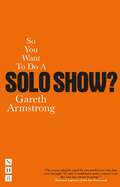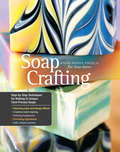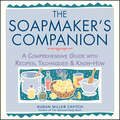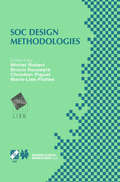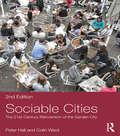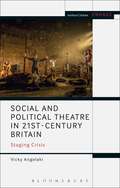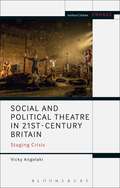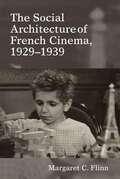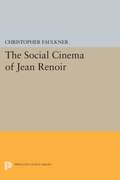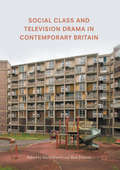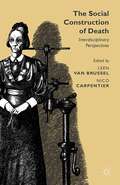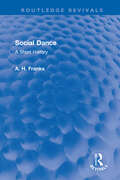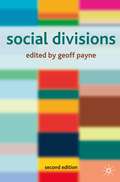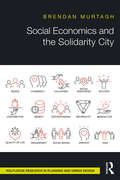- Table View
- List View
So You Want to Publish a Magazine?
by Angharad LewisThe process of creating graphic design cannot be easily defined: each designer has their own way of seeing the world and approaching their work. Graphic Design Process features a series of in-depth case studies exploring a range of both universal and unique design methods. Chapters investigate typical creative strategies – Research, Inspiration, Drawing, Narrative, Abstraction, Development and Collaboration – examining the work of 23 graphic designers from around the world. Work featured includes projects by Philippe Apeloig, Michael Bierut, Ed Fella, James Goggin, Anette Lenz, Johnson Banks, Me Company, Graphic Thought Facility, Ahn Sang-Soo and Ralph Schraivogel. This book is aimed at students and educators, as well as practising designers interested in the working methodologies of their peers.
Soap Crafting: Step-by-Step Techniques for Making 31 Unique Cold-Process Soaps
by Anne-Marie FaiolaMake your own custom-tailored and perfectly formed cold-process soaps! Learn how to use milk jugs and yogurt containers for molds, and how coffee, avocado, and even beer can add unique dimensions to your creations. This encouraging introduction to the art of soapmaking makes it simple to master the techniques you need to safely and easily produce your own enticingly fragrant soaps.
The Soapmaker's Companion: A Comprehensive Guide with Recipes, Techniques & Know-How
by Susan Miller CavitchIn this comprehensive guide, Susan Miller Cavitch covers everything you need to know to make your own soaps. Learn the basic techniques for crafting oil-, cream-, and vegetable-based soaps, and then start experimenting with your own personalized scents and effects. Cavitch provides tips for making more than 40 different specialty soaps, showing you how to design colorful marbled bars and expertly blend ingredients to create custom fragrances. You&’ll soon be making luxurious soaps at a fraction of the cost of boutique products.Important Notice Early printings of this book contain a recipe variation in a sidebar note on page 36. As a result of further testing, author Susan Miller Cavitch and Storey Publishing strongly recommend that you do not try this variation. Adding honey when you are combining the sodium hydroxide and water may result in a stronger reaction with more intense heat. The mixture may bubble up quickly and come out of the pot, posing a potential hazard.
SOC Design Methodologies: IFIP TC10 / WG10.5 Eleventh International Conference on Very Large Scale Integration of Systems-on-Chip (VLSI-SOC’01) December 3–5, 2001, Montpellier, France (IFIP Advances in Information and Communication Technology #90)
by Michel Robert Bruno Rouzeyre Christian Piguet Marie-Lise FlottesThe 11 th IFIP International Conference on Very Large Scale Integration, in Montpellier, France, December 3-5,2001, was a great success. The main focus was about IP Cores, Circuits and System Designs & Applications as well as SOC Design Methods and CAD. This book contains the best papers (39 among 70) that have been presented during the conference. Those papers deal with all aspects of importance for the design of the current and future integrated systems. System on Chip (SOC) design is today a big challenge for designers, as a SOC may contain very different blocks, such as microcontrollers, DSPs, memories including embedded DRAM, analog, FPGA, RF front-ends for wireless communications and integrated sensors. The complete design of such chips, in very deep submicron technologies down to 0.13 mm, with several hundreds of millions of transistors, supplied at less than 1 Volt, is a very challenging task if design, verification, debug and industrial test are considered. The microelectronic revolution is fascinating; 55 years ago, in late 1947, the transistor was invented, and everybody knows that it was by William Shockley, John Bardeen and Walter H. Brattein, Bell Telephone Laboratories, which received the Nobel Prize in Physics in 1956. Probably, everybody thinks that it was recognized immediately as a major invention.
Sociable Cities: The 21st-Century Reinvention of the Garden City (Planning, History and Environment Series)
by Peter Hall Colin WardPeter Hall and Colin Ward wrote Sociable Cities to celebrate the centenary of publication of Ebenezer Howard’s To-morrow: A Peaceful Path to Real Reform in 1998 – an event they then marked by co-editing (with Dennis Hardy) the magnificent annotated facsimile edition of Howard’s original, long lost and very scarce, in 2003. In this revised edition of Sociable Cities, sadly now without Colin Ward, Peter Hall writes: ‘the sixteen years separating the two editions of this book seem almost like geological time. Revisiting the 1998 edition is like going back deep into ancient history’. The glad confident morning following Tony Blair’s election has been followed by political disillusionment, the fiscal crash, widespread austerity and a marked anti-planning stance on the part of the Coalition government. But – closely following the argument of Good Cities, Better Lives: How Europe discovered the Lost Art of Urbanism (Routledge 2013), to which this book is designed as a companion – Hall argues that the central message is now even stronger: we need more planning, not less. And this planning needs to be driven by broad, high-level strategic visions – national, regional – of the kind of country we want to see. Above all, Hall shows in the concluding chapters, Britain’s escalating housing crisis can be resolved only by a massive programme of planned decentralization from London, at least equal in scale to the great Abercrombie plan seventy years ago. He sets out a picture of great new city clusters at the periphery of South East England, sustainably self-sufficient in their daily patterns of living and working, but linked to the capital by new high-speed rail services. This is a book that every planner, and every serious student of policy-making, will want to read. Published at a time when the political parties are preparing their policy manifestos, it is designed to make a major contribution to a major national debate.
Sociable Cities: The 21st-Century Reinvention of the Garden City (Planning, History and Environment Series)
by Peter Hall Colin WardPeter Hall and Colin Ward wrote Sociable Cities to celebrate the centenary of publication of Ebenezer Howard’s To-morrow: A Peaceful Path to Real Reform in 1998 – an event they then marked by co-editing (with Dennis Hardy) the magnificent annotated facsimile edition of Howard’s original, long lost and very scarce, in 2003. In this revised edition of Sociable Cities, sadly now without Colin Ward, Peter Hall writes: ‘the sixteen years separating the two editions of this book seem almost like geological time. Revisiting the 1998 edition is like going back deep into ancient history’. The glad confident morning following Tony Blair’s election has been followed by political disillusionment, the fiscal crash, widespread austerity and a marked anti-planning stance on the part of the Coalition government. But – closely following the argument of Good Cities, Better Lives: How Europe discovered the Lost Art of Urbanism (Routledge 2013), to which this book is designed as a companion – Hall argues that the central message is now even stronger: we need more planning, not less. And this planning needs to be driven by broad, high-level strategic visions – national, regional – of the kind of country we want to see. Above all, Hall shows in the concluding chapters, Britain’s escalating housing crisis can be resolved only by a massive programme of planned decentralization from London, at least equal in scale to the great Abercrombie plan seventy years ago. He sets out a picture of great new city clusters at the periphery of South East England, sustainably self-sufficient in their daily patterns of living and working, but linked to the capital by new high-speed rail services. This is a book that every planner, and every serious student of policy-making, will want to read. Published at a time when the political parties are preparing their policy manifestos, it is designed to make a major contribution to a major national debate.
Social And Critical Practices In Art Education (PDF)
by Dennis Atkinson Paul Dash Manoj Kumar DashThis exciting book shows how children and students can use art to explore personal, social and cultural issues that touch their lives. It covers new ground, responding to increasing diversity and to recent government initiatives worldwide to support active citizenship. That art has a place in this dynamic is clear from the comments of art educators from several countries and working with all ages who write here about their innovative projects with young people. Tim Rollins discusses his work over two decades with disaffected youths in the Bronx and John Johnston describes work in art to bring communities together in Northern Ireland. Dennis Atkinson questions the traditions of art teaching in English Schools, while Henry Ward describes how he engages his secondary school students in contemporary art practice. Danielle Souness and Rob Fairley describe room 13, a dynamic space for art in practice in a Scottish primary school. Viv Golding looks at the use of museums and galleries for teaching young children about art, while Diedre Prins, curator of the Robben Island museum in South Africa, describes some of the art based projects for youngsters. Folami Bayode and Lucy Davies describe a gallery project with disaffected teenagers. Identity is explored or expressed through art by Sarnath Banarjee from India, who uses comics, and by Susan pui san Lok, who explores Chinese and English-Chinese identifications. The rich diversity of our society needs to be incorporated into the art curriculum in schools, argues Paul Dash. This exciting volume is rounded off by Leslie Burgess and Nick Addison's account of how they have developed critical and social practices in teacher education at London's Institute of Education. This wide-ranging and groundbreaking book is for all those working in art education, in museums and galleries, schools and communities.
Social and Political Theatre in 21st-Century Britain: Staging Crisis (Methuen Drama Engage)
by Vicky Angelaki Mark Taylor-Batty Enoch BraterIn a context of financial crisis that has often produced a feeling of identity crisis for the individual, the theatre has provided a unifying forum, treating spectators as citizens. This book critically deals with representative plays and playwrights who have stood out in the UK and internationally in the post-recession era, delivering theatre that in the process of being truthful to the contemporary experience has also redefined theatrical form and content. Built around a series of case-studies of seminal contemporary plays exploring issues of social and political crisis, the volume is augmented by interviews with UK and international directors, artistic directors and the playwrights whose work is examined. As well as considering UK stage productions, Angelaki analyses European, North American and Australian productions, of post-2000 plays by writers including: Caryl Churchill, Mike Bartlett, Dennis Kelly, Simon Stephens, Martin Crimp, debbie tucker green, Duncan Macmillan, Nick Payne and Lucy Prebble.At the heart of the analysis and of the plays discussed is an appreciation of what interconnects artists and audiences, enabling the kind of mutual recognition that fosters the feeling of collectivity. As the book argues, this is the state whereby the theatre meets its social imperative by eradicating the distance between stage and spectator and creating a genuinely shared space of ideas and dialogue, taking on topics including the economy, materialism, debt culture, the environment, urban protest, social media and mental health. Social and Political Theatre in 21st-Century Britain demonstrates that such contemporary playwriting invests in and engenders moments of performative reciprocity and spirituality so as to present the audience with a cohesive collective experience.
Social and Political Theatre in 21st-Century Britain: Staging Crisis (Methuen Drama Engage)
by Vicky Angelaki Mark Taylor-Batty Enoch BraterIn a context of financial crisis that has often produced a feeling of identity crisis for the individual, the theatre has provided a unifying forum, treating spectators as citizens. This book critically deals with representative plays and playwrights who have stood out in the UK and internationally in the post-recession era, delivering theatre that in the process of being truthful to the contemporary experience has also redefined theatrical form and content. Built around a series of case-studies of seminal contemporary plays exploring issues of social and political crisis, the volume is augmented by interviews with UK and international directors, artistic directors and the playwrights whose work is examined. As well as considering UK stage productions, Angelaki analyses European, North American and Australian productions, of post-2000 plays by writers including: Caryl Churchill, Mike Bartlett, Dennis Kelly, Simon Stephens, Martin Crimp, debbie tucker green, Duncan Macmillan, Nick Payne and Lucy Prebble.At the heart of the analysis and of the plays discussed is an appreciation of what interconnects artists and audiences, enabling the kind of mutual recognition that fosters the feeling of collectivity. As the book argues, this is the state whereby the theatre meets its social imperative by eradicating the distance between stage and spectator and creating a genuinely shared space of ideas and dialogue, taking on topics including the economy, materialism, debt culture, the environment, urban protest, social media and mental health. Social and Political Theatre in 21st-Century Britain demonstrates that such contemporary playwriting invests in and engenders moments of performative reciprocity and spirituality so as to present the audience with a cohesive collective experience.
The Social Architecture of French Cinema: 1929–1939 (Contemporary French and Francophone Cultures #34)
by Margaret FlinnFrom the fleetingly captured street scenes of the city symphony, to the meticulously reconstructed studio city of musical comedies; from the propagandistic Popular Front documentaries about construction workers, to poetic realism’s bittersweet portraits of populist neighborhoods: Social Architecture explores the construction, representation and experience of spaces and places in documentary and realist films of the French 1930s. In this book, Margaret C. Flinn tracks the relation between the emergent techniques of French sound cinema and its thematic, social and political preoccupations through analysis of discourse in contemporary press, theoretical texts and through readings of films themselves. New light is shed on works of canonical directors such as Renoir, Clair, Vigo and Duvivier by their consideration in relationship to little known documentary films of the era. Flinn argues that film has a readable architecture—a configuration of narrative and representations that informs, explains, and creates social identities, while reflecting upon the position of individuals within their societies.
The Social Cinema of Jean Renoir
by Christopher FaulknerReinterpreting twelve of Renoir's best-known works, Professor Faulkner attributes their qualities not to the director's unified sensibility but to varying social and historical circumstances.Originally published in 1986.The Princeton Legacy Library uses the latest print-on-demand technology to again make available previously out-of-print books from the distinguished backlist of Princeton University Press. These editions preserve the original texts of these important books while presenting them in durable paperback and hardcover editions. The goal of the Princeton Legacy Library is to vastly increase access to the rich scholarly heritage found in the thousands of books published by Princeton University Press since its founding in 1905.
Social Class and Television Drama in Contemporary Britain
by Beth Johnson David ForrestThis collection is a wide-ranging exploration of contemporary British television drama and its representations of social class. Through early studio-set plays, soap operas and period drama, the volume demonstrates how class provides a bridge across multiple genres and traditions of television drama. The authors trace this thematic emphasis into the present day, offering fascinating new insights into the national conversation around class and identity in Britain today. The chapters engage with a range of topics including authorial explorations of Stephen Poliakoff and Jimmy McGovern, case studies of television performers Maxine Peake and Jimmy Nail, and discussions of the sitcom genre and animation form. This book offers new perspectives on popular British television shows such as Goodnight Sweetheart and Footballers’ Wives, and analysis of more recent series such as Peaky Blinders and This is England.
The Social Construction of Death: Interdisciplinary Perspectives
by Leen Van Brussel Nico CarpentierChapter 12 of this book is open access under a CC BY license. Well-established scholars from a variety of disciplines - including sociology, anthropology, media and cultural studies, and political sciences – use the social construction of death and dying to analyse a wide variety of meaning-making practices in societal fields such as ethics, politics, media, medicine and family.
The Social Context of James Ensor’s Art Practice: “Vive La Sociale!”
by Susan M. Canning“Vive la Sociale”: This rousing, revolutionary statement, written on a bright red banner across the top of James Ensor's Christ's Entry into Brussels in 1889, served as a visual manifesto and call to action by the Belgian artist (1860-1949), one that announced with an insistent, public voice the centrality of his art practice to the cultural discourse of modern Belgium. This provocative declaration serves as the title for this new study of Ensor's art focusing on its social discourse and the artist's interaction with and at times satirical encounter with his contemporary milieu. Rather than the alienated and traumatized Expressionist given preference in modern art history, Ensor is presented here as an artist of agency and purpose whose art practice engaged the issues and concerns of middle class Belgian life, society and politics and was informed by the values and class, race and gendered perspectives of his time. Ensor's radical vision and oppositional strategy of resistance, self-fashioning and performance remains relevant. This book with its timely, nuanced reading of the art and career of this often misunderstood “artist's artist”, invites a re-evaluation not only of Ensor's social context and expressive critique but also his unique contribution to modernist art practice.
The Social Context of James Ensor’s Art Practice: “Vive La Sociale!”
by Susan M. Canning“Vive la Sociale”: This rousing, revolutionary statement, written on a bright red banner across the top of James Ensor's Christ's Entry into Brussels in 1889, served as a visual manifesto and call to action by the Belgian artist (1860-1949), one that announced with an insistent, public voice the centrality of his art practice to the cultural discourse of modern Belgium. This provocative declaration serves as the title for this new study of Ensor's art focusing on its social discourse and the artist's interaction with and at times satirical encounter with his contemporary milieu. Rather than the alienated and traumatized Expressionist given preference in modern art history, Ensor is presented here as an artist of agency and purpose whose art practice engaged the issues and concerns of middle class Belgian life, society and politics and was informed by the values and class, race and gendered perspectives of his time. Ensor's radical vision and oppositional strategy of resistance, self-fashioning and performance remains relevant. This book with its timely, nuanced reading of the art and career of this often misunderstood “artist's artist”, invites a re-evaluation not only of Ensor's social context and expressive critique but also his unique contribution to modernist art practice.
Social Dance: A Short History (Routledge Revivals)
by Arthur FranksOriginally published in 1963 and authored by the then Editor of the Dancing Times, this was a pioneer work discussing not only the origins and development of many social dance forms from early times, but also relating these forms to their environment. As well as its role in social history, the book analyses the role of dance as a prime creative power in Renaissance spectacles which depicted and celebrated diplomatic, military and regal occasions. After a wide-ranging introductory chapter on the origins of dancing, the book takes the reader through the centuries, discussing in turn the Basse Danse and the Moresco of the Middle Ages, the Pavane, Galliard and Courante of the 16th Century, the Minuet of the 17th & 18th, the Allemande, the Waltz and the Polka as well as Jazz, the Cha Cha Cha, the Jive and Twist.
Social Dance: A Short History (Routledge Revivals)
by Arthur FranksOriginally published in 1963 and authored by the then Editor of the Dancing Times, this was a pioneer work discussing not only the origins and development of many social dance forms from early times, but also relating these forms to their environment. As well as its role in social history, the book analyses the role of dance as a prime creative power in Renaissance spectacles which depicted and celebrated diplomatic, military and regal occasions. After a wide-ranging introductory chapter on the origins of dancing, the book takes the reader through the centuries, discussing in turn the Basse Danse and the Moresco of the Middle Ages, the Pavane, Galliard and Courante of the 16th Century, the Minuet of the 17th & 18th, the Allemande, the Waltz and the Polka as well as Jazz, the Cha Cha Cha, the Jive and Twist.
The Social Design Reader
by Elizabeth ResnickThe Social Design Reader explores the ways in which design can be a catalyst for social change. Bringing together key texts of the last fifty years, editor Elizabeth Resnick traces the emergence of the notion of socially responsible design. This volume represents the authentic voices of the thinkers, writers and designers who are helping to build a 'canon' of informed literature which documents the development of the discipline.The Social Design Reader is divided into three parts. Section 1: Making a Stand includes an introduction to the term 'social design' and features papers which explore its historical underpinnings. Section 2: Creating the Future documents the emergence of social design as a concept, as a nascent field of study, and subsequently as a rapidly developing professional discipline, and Section 3: A Sea Change is made up of papers acknowledging social design as a firmly established practice.Contextualising section introductions are provided to aid readers in understanding the original source material, while summary boxes clearly articulate how each text fits with the larger milieu of social design theory, methods, and practice.
The Social Design Reader
by Elizabeth ResnickThe Social Design Reader explores the ways in which design can be a catalyst for social change. Bringing together key texts of the last fifty years, editor Elizabeth Resnick traces the emergence of the notion of socially responsible design. This volume represents the authentic voices of the thinkers, writers and designers who are helping to build a 'canon' of informed literature which documents the development of the discipline.The Social Design Reader is divided into three parts. Section 1: Making a Stand includes an introduction to the term 'social design' and features papers which explore its historical underpinnings. Section 2: Creating the Future documents the emergence of social design as a concept, as a nascent field of study, and subsequently as a rapidly developing professional discipline, and Section 3: A Sea Change is made up of papers acknowledging social design as a firmly established practice.Contextualising section introductions are provided to aid readers in understanding the original source material, while summary boxes clearly articulate how each text fits with the larger milieu of social design theory, methods, and practice.
Social Diversity within Multiliteracies: Complexity in Teaching and Learning
by Fenice B. Boyd Cynthia H. BrockUsing a multiliteracies theoretical framework highlighting social diversity and multimodality as central in the process of meaning making, this book examines literacy teaching and learning as embedded in cultural, linguistic, racial, sexual, and gendered contexts and explores ways to foster learning and achievement for diverse students in various settings. Attending simultaneously to topics around two overarching and interrelated themes—languages and language variations, and cultures, ethnicities, and identities—the chapter authors examine the roles that multiliteracies play in students’ lives in and out of classrooms. In Part I, readers are asked to examine beliefs and dispositions as related to different languages, language varieties, cultures, ethnicities, and identities. Part II engages readers in examining classroom and community practices related to different languages and language varieties, cultures, ethnicities, and identities.
Social Diversity within Multiliteracies: Complexity in Teaching and Learning
by Fenice B. Boyd Cynthia H. BrockUsing a multiliteracies theoretical framework highlighting social diversity and multimodality as central in the process of meaning making, this book examines literacy teaching and learning as embedded in cultural, linguistic, racial, sexual, and gendered contexts and explores ways to foster learning and achievement for diverse students in various settings. Attending simultaneously to topics around two overarching and interrelated themes—languages and language variations, and cultures, ethnicities, and identities—the chapter authors examine the roles that multiliteracies play in students’ lives in and out of classrooms. In Part I, readers are asked to examine beliefs and dispositions as related to different languages, language varieties, cultures, ethnicities, and identities. Part II engages readers in examining classroom and community practices related to different languages and language varieties, cultures, ethnicities, and identities.
Social Divisions
Society consists of people sharply divided from one another, living different lives and with distinct identities. This updated and expanded second edition of a successful text explores each of the social divisions. The book includes three major new chapters, on religion, poverty and elites and is written by leading academics in each field.
Social Economics and the Solidarity City
by Brendan MurtaghSocial Economics and the Solidarity City explores the impact and potential of the social economy as a site of urban struggle, political mobilization and community organization. The search for alternatives to the neoliberal logic governing contemporary cities has often focused on broad and ill-defined political, social and environmental movements. These alternatives sometimes fail to connect with the lived realities of the city or to change the lives of those exploited in neoliberal restructuring. This book seeks to understand the capacity of the social economy to revitalize urban ethics, local practices and tangible political alterity. Providing a critical account of the social economy and its place in urban and state restructuring, this book draws on a range of international cases to argue that the social economy can be made a transformative space. Evaluating community enterprises, social finance, and solidarity economics, author Brendan Murtagh maps the possibilities, contradictions and tactics of moving the rhetoric of the just city into local and global action.
Social Economics and the Solidarity City
by Brendan MurtaghSocial Economics and the Solidarity City explores the impact and potential of the social economy as a site of urban struggle, political mobilization and community organization. The search for alternatives to the neoliberal logic governing contemporary cities has often focused on broad and ill-defined political, social and environmental movements. These alternatives sometimes fail to connect with the lived realities of the city or to change the lives of those exploited in neoliberal restructuring. This book seeks to understand the capacity of the social economy to revitalize urban ethics, local practices and tangible political alterity. Providing a critical account of the social economy and its place in urban and state restructuring, this book draws on a range of international cases to argue that the social economy can be made a transformative space. Evaluating community enterprises, social finance, and solidarity economics, author Brendan Murtagh maps the possibilities, contradictions and tactics of moving the rhetoric of the just city into local and global action.
